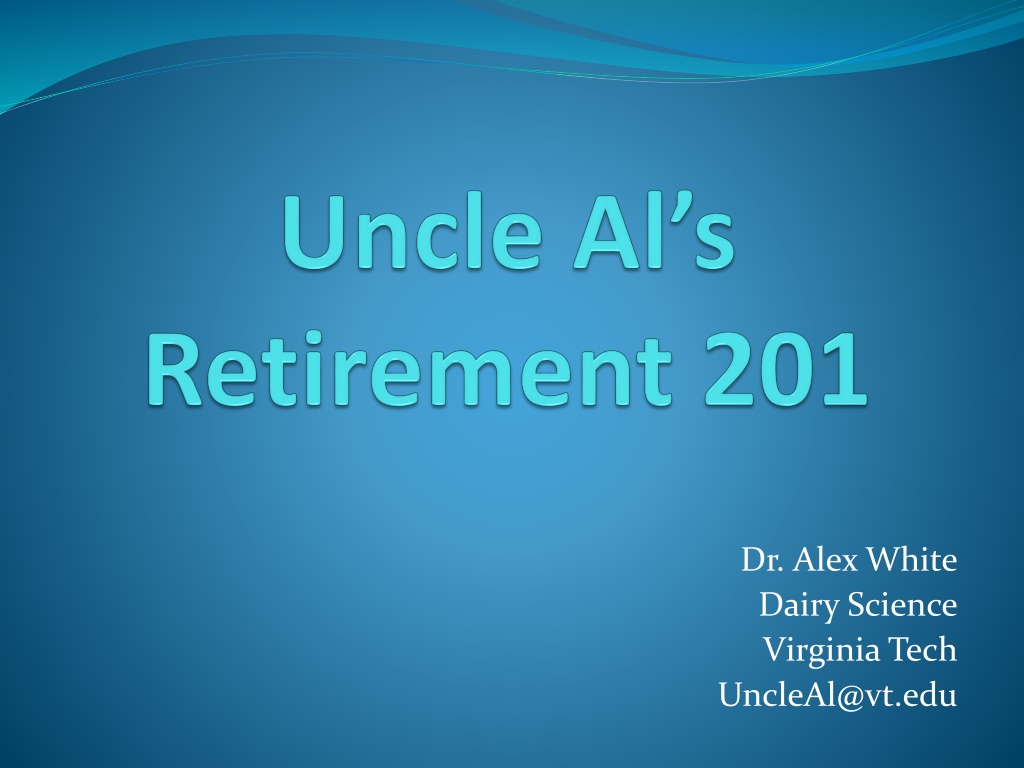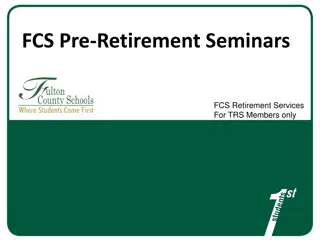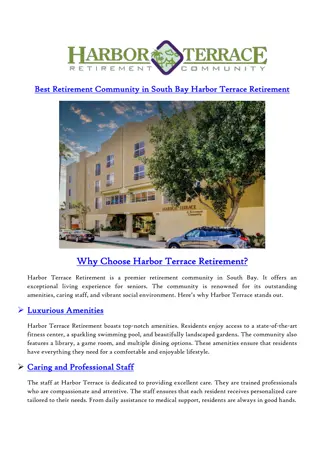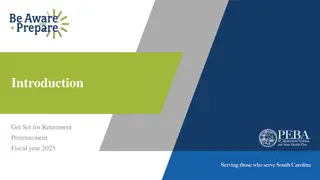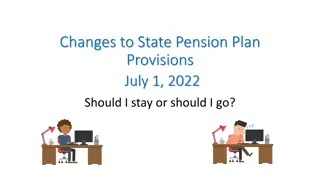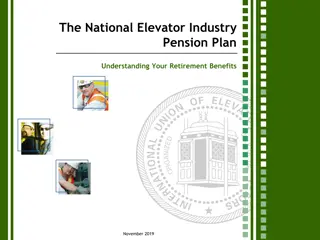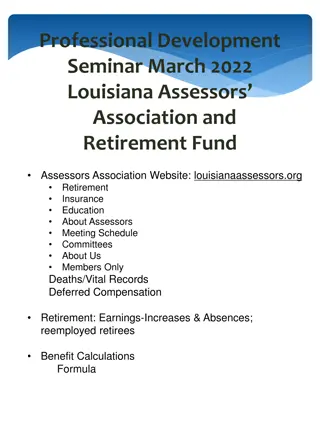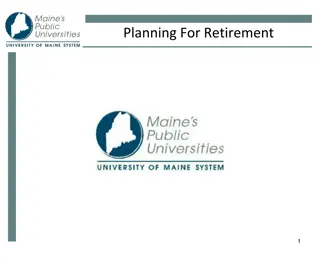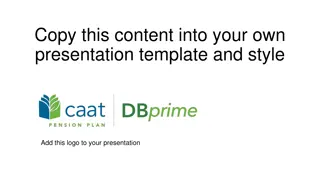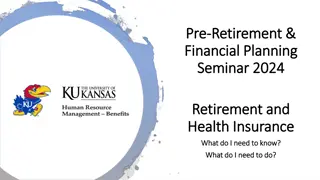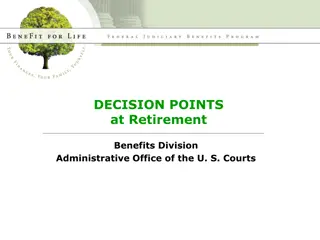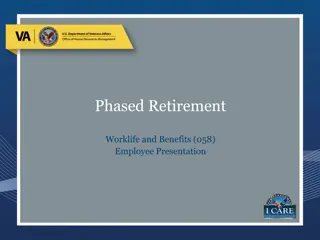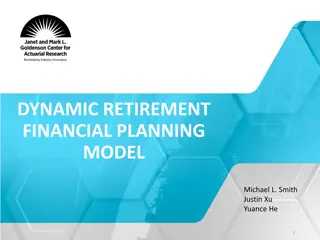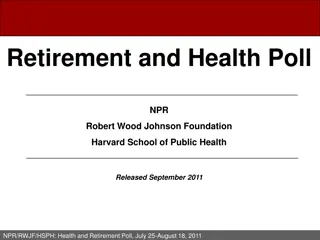Understanding Your Retirement Investment Options
Learn about the primary retirement plans at Virginia Tech, including Defined Benefit and Defined Contribution Plans. Explore supplementary VT plans like 403(b) and Roth 403(b), as well as non-VT options such as IRAs. Understand the impact of before-tax contributions and how to make investment decisions for your future financial security.
Download Presentation

Please find below an Image/Link to download the presentation.
The content on the website is provided AS IS for your information and personal use only. It may not be sold, licensed, or shared on other websites without obtaining consent from the author. Download presentation by click this link. If you encounter any issues during the download, it is possible that the publisher has removed the file from their server.
E N D
Presentation Transcript
Dr. Alex White Dairy Science Virginia Tech UncleAl@vt.edu
Main Goals for Today Understand your main investment plan options How much to invest to reach your goals How to invest the money in your retirement accounts
First Things First Which primary VT retirement plan do you have? VRS Plan 1 Defined Benefit Plans VRS Plan 2 VRS Hybrid Plan ORP Plan 1 Defined Contribution Plans ORP Plan 2
What? Defined Benefit Plans Your retirement benefit is based off: Years of service Average ending salary You earn a specified annual payment or annuity Defined Contribution Plans Your retirement benefit is based off: How your investments perform You develop a pot of money
Next Supplementary VT Plans? 403(b) and Roth 403(b) Up to $18,000/year ($6,000 catch-up) 457 Cash Match (401(a)) 50% of your contribution, up to $20/pay period
Non-VT Retirement Plans Individual Retirement Accounts (IRAs) Traditional IRA Before-tax contributions that lower your income taxes each year No taxes on the earnings while the money is in the account All withdrawals are taxed as ordinary income Roth IRA After-tax contributions Tax-free withdrawals
Setting Up IRAs Where/Who Most banks Most life insurance agents Financial planners Brokerages (Vanguard, etc.) Can make contributions for tax year 2016 up until April 15, 2017 Not locked in to making contributions each year
Impact of Before-Tax Contributions Assume you are in the 25% Marginal Tax Bracket A $1,000 contribution reduces your income taxes by $250 $1,000 x 25% = $250 of tax savings Roughly speaking, you are investing $1,000 at a cost of $750 ($1,000 - $250 tax savings)
Investment Decisions VRS Plan 1 and 2 You don t have to make any investment decisions ORP Plans, VRS Hybrid, 403(b), 457, 401(a), IRAs You need to determine how to invest your funds Typically amongst mutual funds
Investment Decisions Roth or Traditional accounts? Roth is better for: Younger folks and lower-income folks Folks who will be in a higher tax bracket at retirement Traditional is better for: Higher-income folks Folks who will be in a lower tax bracket at retirement
Roth vs Traditional - $5,000/yr Traditional (25% MTB) Tax savings of $1,250/yr 30 years @ 8% = $612,000 (taxable) Provides $41,950/yr for 30 years after taxes Roth Tax savings of $0/yr 30 years @ 8% = $612,000 (completely tax free) Provides $50,350/yr for 30 years
How Much Money Will You Need Need to set your retirement goals What lifestyle do you want? What will that lifestyle cost? Rough guess: 80-100% of your current living expense Rough goals at age of retirement(from all sources): $3-4 million per household $2-3 million $1-2 million 25-year old: 35-year old: 45- year old: Assumes equivalent of $50,000/year in today s dollars for 30 years
Retirement Planning Worksheet Developed by Dr. Alex White, Virginia Tech 40 Years Until Retirement Years In Retirement years years 30 3.50% 8.00% Nominal Inflation Rate Nominal Rate of Return 1. Annual Pre-tax Retirement Living Expenses (in today's dollars) (You'll need roughly 60-80 percent of current income or 80-120 percent of current family living expenses) $50,000 2. Expected Annual Social Security Benefits (in today's dollars) $0 3. Expected Annual Pension Income (in today's dollars) (To estimate - multiply your salary by total years of service (at time of retirement). Multiply this result by 0.012) $0 4. Expected Annual Income From Other Sources (in today's dollars) (From continued employment, sale/lease of assets, .etc.) $0 5. Expected Retirement Income Needed From Savings (Line 1 - Line 2 - Line 3 - Line 4) $50,000 6. Future Value of Additional Income Needed (Line 5 times Factor A - see table below) $197,963 7. Amount Needed at Retirement to Generate Additional Income (Line 6 times Factor X - see table below) $3,425,876 8. Current Value of Savings (This includes all retirement savings and investment accounts. You may include up to 1/2 of your equity in your house and/or other business assets if you expect to sell these assets to fund your retirement) $20,000 9. Expected Future Value of Current Savings (Line 8 times Factor B - see table below) $434,490 10. Average Annual Contributions to Retirement Investments (This includes annual contributions to ORP, 403(b), 457, 401(k), IRAs, SEPs, and Keogh retirement plans) $0 11. Expected Future Value of Current Annual Contributions (Line 10 times factor C - see table below) $0 12. Total Retirement Capital You Need to Accumulate $2,991,386 (Line 7 - Line 9 - Line 11) Additional Annual Savings Needed to Reach Your Retirement Goal (Line 12 times Factor D - see Table below) $10,692 Years to Retirement 4% Factor A 8% Factor B Factor C Factor D 2 4 6 8 10 1.41 2.16 12 1.51 2.52 14 1.62 2.94 16 1.73 3.43 18 1.86 4.00 20 1.99 4.66 25 2.36 6.85 79.0 0.013 0.008 0.005 0.00357 30 2.81 10.06 14.79 122.3 186.1 35 3.33 40 3.96 21.72 279.8 1.07 1.17 2.25 0.445 0.205 0.126 0.087 0.064 0.049 0.038 0.031 0.025 1.15 1.36 4.87 1.23 1.59 7.92 1.32 1.85 11.49 15.65 20.50 26.15 32.75 40.45 49.42 0.02 Years in Retirement 4% Factor X 2 4 6 8 10 12 14 16 18 20 25 30 35 40 1.958 3.757 5.409 6.926 8.319 9.598 10.77 11.85 12.84 13.75 15.72 17.31 18.59 19.626 Modified from a Money Magazine article. Original author & citation are unknown.
Tailor It to Your Situation Years until you retire Years that you plan to be retired Nominal Inflation Rate I use 3-4% for general inflation Might want to bump it up due to medical costs . Nominal Rate of Return Average rate of return of your investments over time When in doubt, use 6-7% for long term planning
More Tailoring Line 1 Annual Pre-Tax Retirement Living Expenses This is in TODAY S Dollars If you are comfortable with your lifestyle today, use the annual cost of your current lifestyle (including taxes) Line 2 Estimate your annual Social Security retirement benefits (SSA.gov) When in doubt, use $0 Line 3 Annual Pension Income Use your VRS Defined Benefit estimate
More Tailoring Line 4 Other Income Rental properties, second careers, etc. Line 8 Current Value of Savings Use the current balance of your defined contribution accounts (ORP, VRS Hybrid, 403(b), 457, 401(a), IRAs) Include up to 50% of the equity in your house if you plan to sell your house for living needs
Even More Tailoring Line 10 Annual Contributions Enter the current amount you are contributing per year to ORP, Hybrid, 403(b), 457, 401(a), and IRAs Line 12+ Additional Contributions Needed This is your new goal!
VRS Plan 1 & 2 What if VRS won t provide enough for your needs? You need to invest more money First contribute to a 403(b) or 457 account Invest $40/pay period to get the maximum cash match Next contribute more to your 403(b) or open an IRA IRA offers more flexibility, but lower limits ($5,500/yr) Is an IRA better than a 403(b) or 457? Only if you want more control over your investments
ORP Plan 1 & 2 What if ORP won t generate enough funds? A. You can take more risk in your ORP investments Higher risk potential for higher returns Are you comfortable with added risk? B. Open a 403(b), 457 (and/or an IRA) Get the cash match! C. Or both A and B
Hybrid Plan What if the Hybrid Plan won t provide enough? A. Maximize your voluntary contributions (4%) B. Take more risk in your investments C. Open a 403(b) or 457 (and/or IRAs) Get the cash match Must maximize your voluntary contributions first
What If I Cant Do These Things Main options: Delay your intended retirement date A few years makes a big difference Reduce your desired retirement lifestyle
How Do I Invest My Funds? ORP, Hybrid, 403(b), 457, 401(a), IRAs You need to choose your investments Menu of mutual funds VT HR cannot tell you which funds to choose Liability reasons You can talk to the TIAA-CREF, Fidelity, & ICMA reps In-person or 1-800 numbers
Easy Way to Invest Use the Lifestyle (aka Asset Allocation ) funds Look for a year in their titles - 2050 fund The year represents your intended year of retirement Want less risk - choose a year before your intended retirement Want more risk choose a year after your intended retirement Example: I plan to retire in 15 years Choose the 2030 or 2035 fund These funds become more conservative as your retirement date approaches good idea
Lifestyle Funds You are not locking in your retirement date Just choosing a fund that approximates your retirement You can use several of these funds if you want 2030, 2035, 2040 etc. These funds continue to earn returns after the year in the title of the fund They just invest very conservatively
Uncle Als Easy Allocation So, you want to do your own investing? Please diversify your investments Don t put everything into just one fund Unless it s a Lifestyle-type fund The Age Rule Your age = % of portfolio in relatively conservative funds Money market funds, bond funds, capital preservation 100 Age = % in more aggressive funds Stock index funds, real estate funds (REITS), global funds
Riskier vs Less Risky Funds Equities (Stocks) Large Cap Mid-Cap Small Cap International Stocks REITS Precious Metals Fixed ( Bonds ) Money Market ST Bonds INT/LT Bonds International Bonds
Allocation Tips Match your investments to your: Time horizon (years until retirement) Risk tolerance Uncle Al s Risk Rule If your investments keep you awake at night, you have too much risk in your portfolio Revise your allocations every couple of years Move to a slightly more conservative allocation More Fixed , more Large Cap Less International, less Small Cap, less Real Estate
Young Employee (age 30) Example Equities (70%) Large Cap Mid Cap Small Cap International REITs Precious Metals 1-3% Fixed (30%) ST 0% INT/LT 20% International 10% 30% 10% 10% 10% 10%
Young Employee Higher Risk Equities (80%) Large Cap Mid Cap Small Cap International REITs Precious Metals ~1-3% Fixed (20%) ST 0% INT/LT 10% International 10% 30% 10% 20% 10% 10%
Procrastination is Your Enemy! Don t wait start NOW! Open that 403(b) or 457 and get the cash match Pay yourself first! Start small and work your way up but START!! Ask for help HR & Wellness programs TIAA, Fidelity, ICMA representatives Financial advisors (for a fee)
So What? Understand your VT retirement plans Which do you have? How does it work? Estimate your retirement living needs Uncle Al s Retirement Planning Worksheet (email me) Remember, it s an educational tool Open that 403(b) or 457 and contribute to it Tax benefits, cash match, painless and brainless Ask for help Just START!!
